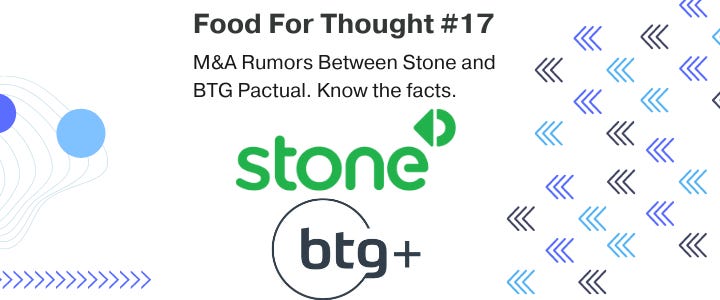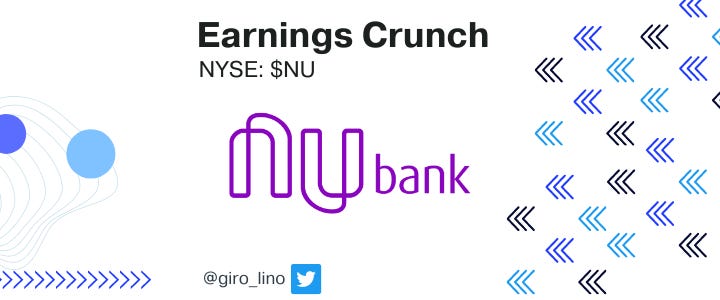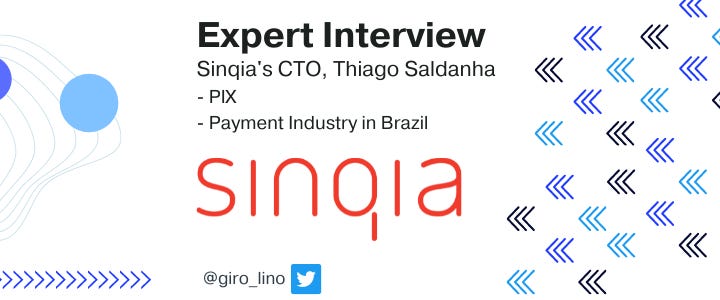I write a lot of stuff, so the idea is to offer a filter to what you cannot miss. Enjoy it.
The ranking is based on unique views, free/paid new subscribers, and open rate — all relative.
Top 5🌟
30 Days
- MercadoLibre ($MELI)
- Food for Thought #16 (FED and China)
- Food for Thought #17 (About Stone)
- Stone's Biggest Moat
- Brazil April Wrap-Up
7 Days
- Food for Thought #17 (About Stone)
- Stone's Biggest Moat
- $SE 1Q22: Upside Risk on Monetization
- $NU 1Q22: The Purple Wave
🌟 Top Percentile on Unique Viewers
5-min recap on what we wrote this week
Food for Thought🌟
- Since Thursday, the market has been speculating that BTG Pactual and Stone would be negotiating an M&A.
- What is in there for BTG Pactual? Stone is one of the top five players in the industry, with a considerable capillarity, good tech resources for scaling its operations, and top-notch logistic capabilities.
- The market still has a high consideration for Street, so he returned and joined meetings with crucial investors — we had access to a person who joined one of those meetings and took a few notes.
- We believe Esteves knows that his name associated with Street's would fully restore investors’ confidence in management and probably would use this to convince Street.
- What is in there for Stone? Even though Stone isn't facing a liquidity issue, the company could use more resources to accelerate its strategy and resume its credit operation.
- With BTG, Stone could strengthen its position as a payment gateway for merchants using BTG's capital to leverage the existing operation.
- Also, we wrote yesterday about a new player gaining market share in the Brazilian Payment Industry that faces a new threat to market participants.
- Stone could leverage its platform to gain stickiness with its clients by offering complex products, such as lending, insurance, investment, etc.
Keep Reading 🔽🔽🔽

Big Piece on Stone 🌟
- In the past years, we’ve heard that the most significant competitive advantage Stone had was its tech, though it always sounded like an empty speech.
- Tech is important, indeed. It enables the company to expand over a smaller structure, minimizing the growth friction and improving sunk costs over time.
- However, we see tech as an enabler, not a competitive advantage. If you had Stone’s software, you would not be able to compete against them. Stone’s most significant competitive advantage relies on distribution due to its hub strategy.
- Stone’s strategy is looking for cities with +500k inhabitants in Brazil as a possible spot for a hub. Usually, they place ten sales representatives, three logistic employees and one leader for 100sqm rented spaces.
- The sales team's goal evolves to increase the number of clients, lower the churn, solve daily routine problems, such as malfunctioning POS machines, and, mainly, sell pre-payment to customers.
- Also, Stone offers to franchisees most of the back-office needed for the operation (HR, Accountancy), reducing the back-office costs for the business owner.
- There is a substantial competitive differential having franchises in smaller locations. First, incumbents, such as Itaú (Rede), and Cielo, will never (ever) sell franchise licensing.
- Second, franchises allow Stone to offer a last-mile solution in smaller regions. For instance, imagine you own a restaurant and operate under Cielo. It’s 12:30PM, the restaurant is full, and your POS dies.
Keep Reading 🔽🔽🔽

$SE 1Q22: Upside Risk on Monetization🌟
- We’ll go briefly on Sea’s earnings and its highlights in this post. Then, we intend to extend to a discussion about the company’s operation in LatAm.
- Sea Limited ($SE, “Shopee”, “Shopee Brazil”) reported 1Q22 results, largely in-line on the top line and much better than expectations on cash burn level.
- The eCommerce segment delivers GMV growth of 39% YoY, while its cash burn also lowers QoQ. We welcome the message from management that Sea may achieve profitability sooner than expected.
- Also, management reduced its GAAP revenue guidance to US$8.5-9.1bn from US$8.9-9.1bn reflecting the growing uncertainties in macro conditions, which could impact the spending power of consumers.
- We believe that the guidance now implies that the GMV growth outlook for 2022 is now +30-40% YoY for the consolidated company, with LatAm growing 100% YoY.
- Management reaffirmed that they focus on profitability over growth, which is an encouraging message. As a result, we believe Sea could deliver high double digits growth without cash burn, which, in our view, would be great.
- The positive highlight was the monetization increase in the eCommerce operation, as the GAAP marketplace revenue as a percentage of total GMV rose to 7.2% during the quarter compared to 5.7% last year.
- As expected, gaming faced pressure in 1Q22, with bookings down 24% QoQ. However, the company started to see the monthly user trend showing early signs of stabilization towards the end of 1Q22.
Keep Reading 🔽🔽🔽

$NU 1Q22: The Purple Wave
- Nubank reported a $45mn net loss vs. the company-provided consensus of a $77mn loss. Similar NPL rises to the incumbent consumer segment, but without payroll and mortgage to smooth the hit.
- We see the quarter with solid credit balance growth. Specifically, total loans rose 122% YoY. In addition, consumer loans, an investor focus, rose to $2bn and now represent 23% of total loans vs. 21% in 4Q21.
- Card TPV rose to $15.9bn, up ~112% YoY and ahead of GIROe's $14.8bn. Interchange revenues increased 127%, with flattish yields at 1.19%.
- Asset quality did not erode as most buy-side analysts expected, with 90-day NPLs up 70bps QoQ vs. Bradesco’s consumer segment’s 60bps and Itau’s 30bps, although this comparison tells only half true (keep reading).
- While fast loan growth helps NPLs, we see Nubank’s figures as substantially better than other neobanks. Provisions rose 287% YoY, driven by loan growth. Overall, Nu presented a strong beat vs. our expectations.
- Under IFRS9, Nubank has to front-load the recognition of credit loss provisioning whenever a loan is booked. So, the faster Nubank grows the credit book, the more short-term pressure it brings to our gross profit margin.
- We must consider how interest on cash balance hurts the short-term PnL. As interest rates go up, Nubank earns more money on our large pool of cash balance, even if it is partially or wholly offset by higher funding expenses.
- But it drives our revenue up and leaves our gross profit essentially unchanged. This pushes down our gross profit margin as it enlarges the denominator of the gross profit formula.
- We ran a few tests assuming stable growth (only to offset churn) and rates at 6%-8% and found a 55%-65% range for gross profit (versus the actual 34% in the 1Q22).
Keep Reading 🔽🔽🔽

Expert Interview - Sinqia
- Giro: The market had problems related to the registration of receivables, which impacted TAG (Stone), and some players, such as N26, are still having difficulty putting the PIX on the street, while others face problems related to latency or settlement. Why do you believe that players are having difficulties? Is it related to the design proposed by the regulator, or is there another reason?
- Saldanha: Every innovation has advantages and difficulties. If you take Open Banking, why didn't it pop and Pix went? The Open Banking concept is a road that needs to be built.
- Pix is transactional. The market was not prepared for this. It's a 24/7 model with an SLA (“Service Level Agreement”) ready for it. The banks were not ready for that. The provider may be ready, but he needs to connect it all to the legacy.
- The bank needs one year and two more to implement to carry out a legacy structure, although they only had two years to prepare.
- The Central Bank protected itself a lot in the regulatory environment. Of course, there was a problem with timing the distribution of Central Bank regulations, but it was always very clear and transparent about the rules.
- In fact, he always gave options, such as indirect and direct Pix. If you don't have the conditions to perform, you can opt for indirect and pay a fee for it. Banks have been able to adapt, while others opt to switch to software.
- Perhaps the PIX is the most sensitive topic. However, with over 12 months on the road, Pix is a huge success in P2P transactions, even if retailers are still not convinced about him.
Keep Reading 🔽🔽🔽






